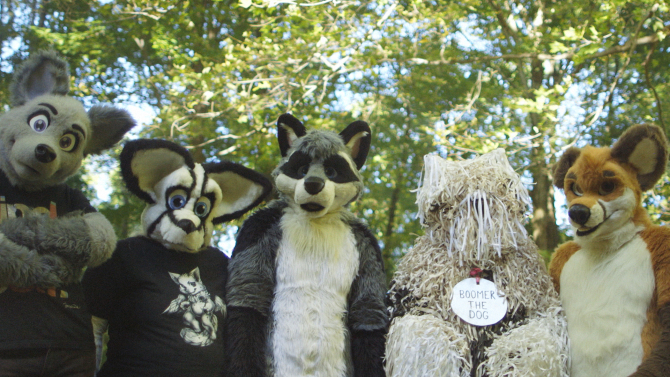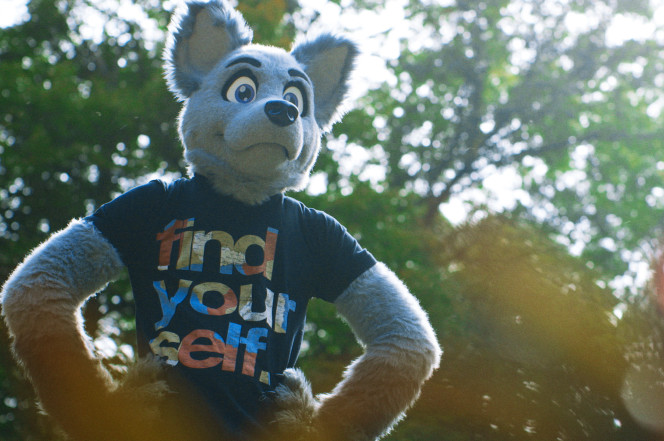When it comes to expression – more and more people are opting to go individual and often unique ways of expressing themselves with an example being the furry culture.
As the world becomes a more populated place we will inevitably diverge into various sub cultures. More people in a central location the higher the chances that there will be more and more people which whom will associate with a particular identity, or sub-culture.
This situation is seen more as we become a more interconnected world. Even if one is not in the physical location of a particular group then they can still become connected and interact with that group through technology. So we are seeing sub-sets of culture spring up all over the place.
Why Are People Unsure about the Furry Culture?
When individual expression diverges from mainstream expression – it is often seen as ‘weird’, ‘odd’, ‘perverse’ and various other negative things. As with anything, things that are not widely understood are often shunned, ridiculed and pushed to the side for seemingly more mainstream expressions.
Lifestyles of those that identify as being a furry fall into this category.
This identity is quite often misunderstood. Often labelled as a sexual perversion, linked to paedophilia, beastiality and other illegal behaviours. This article seeks to break down that barrier, and provide an insight into such a misunderstood sub culture.
What is Furry Culture?
Furry culture is often misunderstood because it can be so incredibly complex as there are sub sections of furries culture. People will associate with the culture and interact with it differently.
There are many kinds of identities within the culture. It would be a tragedy to attempt to define the culture through generalisations. At its core, Furry Culture relates to people that identify, and have a keen interest, with anthropomorphised animals.
Anthropomorphism is giving animals human like qualities and behaviours. This could involve giving an animal the ability to talk, walk on two legs, have distinctly human facial expressions. Or the ability to convey emotions, human like intelligence or even the ability to wear clothes.
Examples of anthropomorphism are Winnie The Pooh, George Orwells Animal Farm, Mickey Mouse, most Disney films all contain examples.
Some Consider the Furry Community as a Fandom
48% of the Furry community consider themselves more of a fandom such as other Cosplayers. It is not or at least not a major part of their sex lives. They just love to get dressed up, emulate their favourite anthropomorphic characters from books, tv, art and games.
Have conventions and get together’s with other Furries and feel the sense of fun and belonging of being in a community with a shared passion.
In contrast flipper, lassie, and other such animal characters are not furries as they do not display human qualities in the slightest. Thomas the Tank Engine and the teapots from Beauty and The Beast have human qualities, they are not considered to be furries as they are not animals.
Furry Interests Often Come from Childhood
It is quite clear that furry interests often come from childhood and an appreciation of various children’s shows and cartoons. A basic understanding of the origins of furry culture. This is because there are a myriad of other aspects to it which include artworks, literature, films, comics, pop culture etc.
Zootopia Caused Contraversy
One of the most recent events involved a condemnation of the film Zootopia, which saw Pop Icon Shakira portrayed as a singing Gazelle surrounded by, arguably Queer, dancing tigers.
People were unhappy with this film as they saw it as supportive of the furry lifestyle. They argued that it was a dangerous film to show this to kids as it was inappropriate to expose them to a perverse lifestyle.
Some Furries don’t Feel human
Furries even feel that they are in fact not entirely, or not at all human. Some feel that they have an animal or anthropomorphic ‘spirit’ in a human body or are a different species altogether.
If you are interested in learning more about this, try googling ‘Otherkin‘.
Furries report that their gender is actually an animal or anthropomorphic expression rather than a traditional gender. These are more unusual. 35% of Furries do report that they don’t ‘feel 100% human’.
Most of the Furry community feel that they are human
Just having a strong interest in animals and anthropomorphic creatures, and are transgender. Or have a more traditional gender, or identify under the trans umbrella, are intersex, agender, gender fluid, bi gender, etc.
Interestingly, on average, Furries are more likely to be young, male, and identifying on the LGBTQI+ spectrum than the rest of the population. Anyone can be a Furry if they want to be and there is a diverse population involved.
Even Buzzfeed generalised furry culture by stating that there were ‘already furry artists at work drawing the female rabbit character in the nude’.
There is an Assumption that Furries are Sexualised
And that furry culture contains strong sexual aspects. The thing is whilst furry culture does have a sexual aspect to it, it is not primarily or exclusively sexual and people will connect to the culture in various ways.
This could include the simple act of wearing ears, or some other animal feature such as a tail. They may dress ‘normally’ but behave in animal like ways adopting a persona which in furry culture is called a Fursona.
What is a Fursona?
A Fursona is a representation of themselves in their chosen anthropomorphic or animal form. It may be of a particular animal including big cats, wolves, foxes, horses, cat, dog and even dragons.
A Furry may have more than one Fursona. They may not demonstrate or display a fursona in real life, but adopt one through online interaction in chatroom’s, through Avatars, or through dedicated furry websites. Some disregard any of these features and simply enjoy Furry based art, pop culture, comics etc.
Furries are Not Harmful to Anyone
Nor anything remotely perverse. From that point they may choose to purchase fursuits, dress up specifically as an animal of their choice, wear masks, or other identifying features.
Furry costumes can be quite expensive.
Especially for good quality ‘Fursuits’. Many Furry fans wear partial costumes instead – ears and tail, for example. Fursuits are made from faux fur such as you would buy a a fabric store, not real animal fur.
Typically Furries take extremely good care of their fursuits
They are both expensive and treasured items. This is often called Furry Life-styling. It describes furry behaviour that transcends simply liking artwork and a love of the furry culture and furry etiquette and involves actually living and/or experiencing it.
This could simply mean exhibiting a specific sound within a social group, or painting, or wearing various costumes . Often ‘scritching’, such as you would do to a pet, and other animal-related shows of affection are shared between Furry friends.

Furry Lifestyle Can be Complicated
From here it gets a little complex, as with personalities. There are different fursonas and most furries will identify with or as a particular species of animal.
It is at this point where many people assume that furries get involved for sexual reasons. In actual fact due to the price of the suits there are very few people that engage in sexual activity whilst wearing a suit. Many people have strong imagery of people dressed up as animals engaging in sexual play, when in actual fact, this is rare.
Furry culture for the most part, except Furry porn and adult products like butt plugs with faux tails, is not focused on sex and sexuality.

A Term ‘yiff’ is often used to refer to Furry sexual activity
Some of the ways it is expressed are through Furry themed pornography and erotica, cybersex between Fursonas, sex while wearing fursuits and role-playing.
There is a definite subsection of Furries who view being a Furry as a strong part of their sexual life. A small percentage of Furries report an interest in zoophilia (a sexual attraction to real animals) and a smaller percentage in ‘plushophilia‘ (a sexual attraction to ‘plushy’ toy animals.)
It should never be presumed that because a someone is a Furry that they harm animals, however. Even the small percentage interested in zoophilia do not necessarily engage in actual sexual activity with non human animals (bestiality.)
Where Do Furries Come From?
The birth of furry culture is argued, some argue that it originated through the novels of Felix Salten which were published between 1926 and 1945. Others argue that it developed through the work of other artists.
According to Fred Patten a historian in fandom folklore, it wasn’t until a science fiction convention in 1980 that the term Furry was coined. Many people feel that furry culture is a new concept. But furry culture has existed online from the early 1990’s which is basically when the internet started to become accessible in households.
It has been theorised through social studies that there is a correlation to exposure of cartoons during childhood. This has led some parental groups to refuse to allow their children to watch cartoons. As with any study – there are other studies that find no such link.
Dr Gerbasi completed a study published in 2008 titled Furries from A to Z
In an attempt to ascertain whether people who identified as furries exhibited signs of some form of personality disorder. Data that Gerbasi put forward resulted in the determination that furries are a male dominated sub-culture with a very wide range of sexual orientation.
Ultimately, the subjects that were interviewed did not demonstrate any known traits of current personality disorders. This leads us to the question that if there is not a specific reason for being a furry…
Why is it such a significant sub-culture?
As with any sub-culture – when it comes to media representation of the culture they often focus on the darkest, more perverse aspects of a culture. Regardless of how small a part of the culture that is.
This tendency towards sensationalised news and for the purpose of click-baiting and the development of an ‘interesting story’, is where the majority of the general public derive their understanding of ‘furry’ from.
It’s deeper than that.
Furry is an expression, a form of expression that is unique to that individuals feelings, personality, and conduct. That expression has the opportunity to create a liberating and safe place for a variety of reasons. They may use that to explore sexual identities, or to become more comfortable and aware of themselves and others.
Helping Overcome Social Difficulties
One academic researcher has suggested that it is an ideal way for people with social difficulties to become more confident within themselves. It takes away all of, or some of, the ‘human’ element of their social interactions.
A sexual aspect is a sub-culture of furries, and it is often the most over and misrepresented aspect of furry culture. It is for the most part, a harmless sexual expression. Many people are disturbed by it because it appears to be foreign to them.
Same can be said of a lot of fetishes out there, as well as a lot of sexual behaviour.
Furry sexuality is viewed as slightly different
Due to its perceived removal from humanity and social culture. Realistically, fursuits are expensive and take a conceivable amount of time to create.
A quick glance online will reveal that full fur suits start upwards of $400 dollars, and can take up to four months to complete, with the most detailed fursuits costing thousands. As such, it is inconceivable that people are going to engage in sexual activity within a fur suit.
Fact of the matter is that this aspect of furries is often the hot topic, as when one searches for furries it is inevitably of a pornographic nature. It is important to note however, that furry porn is completely different, though admittedly a part of, furry culture.
10 Misconceptions About Furries
- Furries are sexual deviants and is always a sexual thing.
- Being a furry means that you must appreciate art and artistic talent
- Furries feel betrayed by the media. Often categorised in the darkest parts of the fandom as the media focuses here for the purpose of click baiting and sensationalised news stories.
- Being a Furry is always safe. People that do not understand furries or their sub-cultures will often bully or be aggressive.
- Fursuits are not complex works of art and can be very expensive.
- Furries are a secretive and exclusive group.
- They are not a vastly diverse group of people. Like most sub cultures there are a myriad of identities, sexualities, ethnicities etc when it comes to identifying as a furry.
- The Furry Fandom is not seen as a safe place.
- Finding your ‘species’/Fursona takes no time. Some people take years to develop their true fursona.
- Fursuits are a requirement.
Furries Are Nothing to be Afraid of

Meet Stephen, a bold and opinionated cis-gendered gay advocate for gender equality and sexual education. Join him on the Adultsmart blog for fearless insights.








Leave a Reply